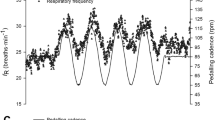Summary
The relationship between pedalling- and breathing rhythm was studied in 34 medical students (“non-cyclists”) and 10 racing cyclists on an electromagnetic bicycle-ergometer, the effective work load of which (50 W, 100 W, 150 W, 200 W) was independent of the pedalling rate. The criteria used were integer p/b ratios (pedalling rate being a multiple of breathing frequency) and phase coupling (the breathing phases starting preferentially at a certain angle of the pedalling cycle).
Unconsciously occurring coordination of pedalling and breathing rhythm was found in the majority of the test persons; 70%–100% of the racing cyclists, 50%–63% of the regularly breathing and 25%–33% of the irregularly breathing non-cyclists showed integer p/b ratios. This tendency decreased with increasing work load. Phase coupling was even more frequent than integer p/b ratios and was not affected by increasing work load. The majority of racing cyclists (unlike the non-cyclists) coupled the inspiration-onset with the onset of either the left or the right leg movement. Expiratory phase coupling, however, was analogous in all groups; expiration began preferentially at mid-contraction of either leg.
The results are discussed in terms of relative (nervous) coordination. It is concluded that the tendency to coordination between pedalling- and breathing rhythm increases with pedalling training and with regularity of breathing.
Similar content being viewed by others
References
Agostoni E, D'Angelo E (1976) The effect of limb movements on the regulation of depth and rate of breathing. Respir Physiol 27: 33–52
Anders P (1928) über den individuellen Eigenrhythmus beim Gehen und Beziehungen zu Herz- und Atemfrequenz. Pflügers Arch Ges Physiol 220: 287–299
åstrand PO, Rohdal K (1970) Textbook of work physiology. McGraw Hill, London
Bechbache RR, Duffin J (1977) The entrainment of breathing frequency by exercise rhythm. J Physiol (Lond) 272: 553–561
Cohen MI (1979) Neurogenesis of respiratory rhythm in the mammals. Physiol Rev 59: 1105–1173
Dejours P (1959) La règulation de la ventilation au cours de l'exercise musculaire chez l'homme. J Physiol (Paris) 51: 163–261
Dempsey JA, Vidruk EH, Mastenbrook SM (1980) Pulmonary control systems in exercise. Fed Proc 39: 1498–1505
Hildebrandt G, Daumann FJ (1965) Koordination von Puls- und Atemfrequenz bei Arbeit. Int Z Angew Physiol 21: 27–48
Holst E von (1939) Die relative Koordination als PhÄnomen und als Methode zentralnervöser Funktionsanalyse. Ergeb Physiol 42: 228–306
Iscoe S, Polosa C (1976) Synchronization of respiratory frequency by somatic afferent stimulation. J Appl Physiol 40: 138–148
Kao FF (1963) An experimental study of the pathways involved in exercise hyperpnoea employing cross-circulation techniques. In: Cunningham DJC, Loyd BB (eds) The regulation of human respiration. Blackwell, Oxford, pp 461–502
Kay JDS, Petersen ES, Vejby-Christensen H (1975) Breathing in man during steady state exercise on the bicycle at two pedalling frequencies and during treadmill walking. J Physiol (Lond) 251: 645–656
Kelman GR, Watson AWS (1973) Effect of added dead-space on pulmonary ventilation during sub-maximal, steady-state exercise. Q J Exp Physiol 58: 305–313
Kisselkova H, Georgiev V (1979) Effects of training on postexercise limb muscle EMG synchronous to respiration. J Appl Physiol 46: 1093–1095
Panda A, Senapati JM, Parida B, Fahim M (1979) Role of cerebellum on ventilatory change due to muscle-receptor stimulation in the dog. J Appl Physiol 47: 1062–1065
Saunders JA (1947) Respiratory rhythm and rhythm of body movement in the human. J Physiol (Lond) 106: 25P
Schwarz G (1973) über die VerÄnderungen der Herz- und Atemperiodenstreuung bei Tretarbeit mit verschiedenen Frequenzen und ihre Beziehung zum Trainingszustand. Inaug Diss, Marburg
Smirnov KM (Ed) (1974) Sportphysiologie. VEB Verlag Volk und Gesundheit, Berlin
Viala D, Vidal C, Freton E (1979) Coordinated rhythmic bursting in respiratory and locomotor muscle nerves in the spinal rabbit. Neurosci Lett 11: 155–159
Wiley RL, Lind AR (1975) Respiratory responses to simultaneous static and rhythmic exercises in humans. Clin Sci Mol Med 49: 427–432
Author information
Authors and Affiliations
Additional information
Supported in part by a grant from the “Hartmann-Müller-Stiftung für medizinische Forschung, Zürich“
Rights and permissions
About this article
Cite this article
Kohl, J., Koller, E.A. & JÄger, M. Relation between pedalling- and breathing rhythm. Europ. J. Appl. Physiol. 47, 223–237 (1981). https://doi.org/10.1007/BF00422468
Accepted:
Issue Date:
DOI: https://doi.org/10.1007/BF00422468




